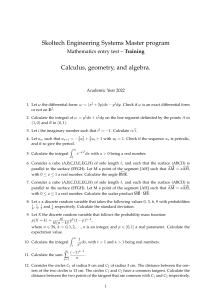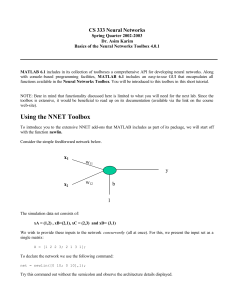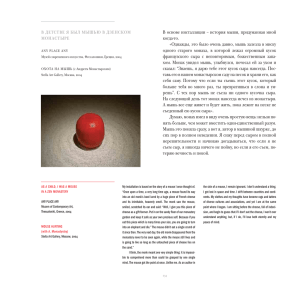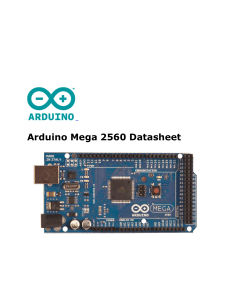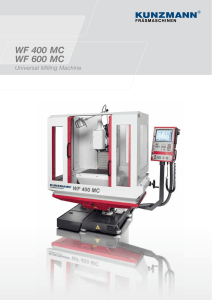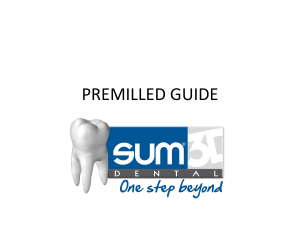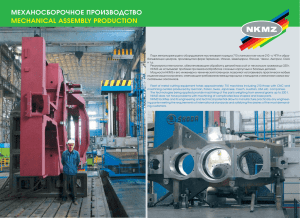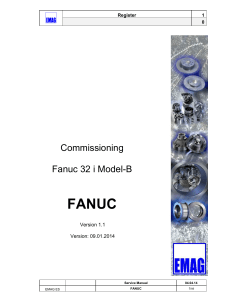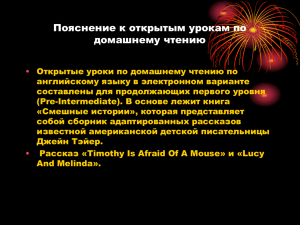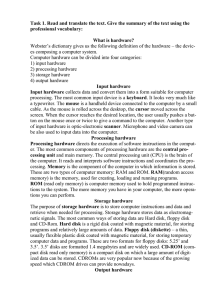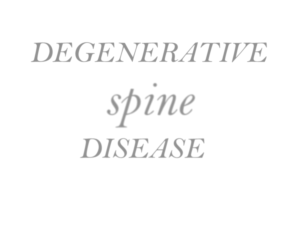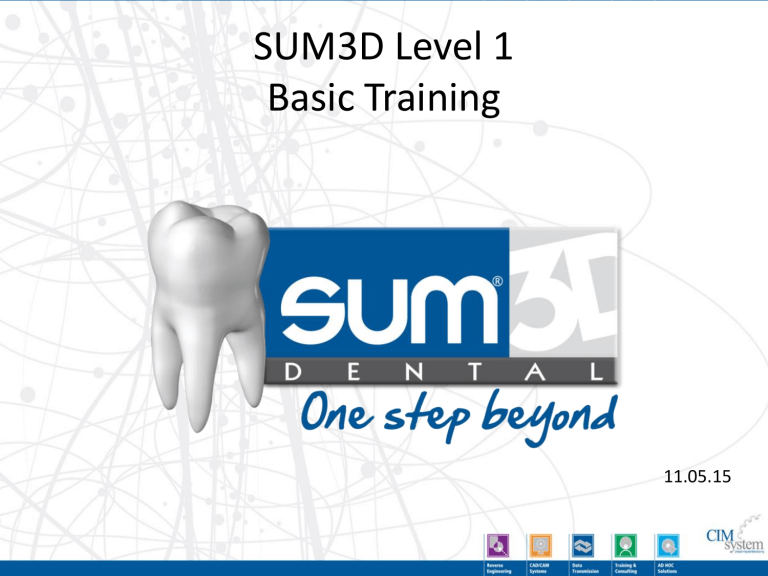
SUM3D Level 1 Basic Training 11.05.15 SUM3D Workflow NEW JOB (.CAM) Import .STL Import Stock (Nesting) Calculation (NC FILE) Interface Zoom & Viewing Toolbar Workflow Wizard (Primary Toolbar) Imported Strategy Information Equipment (Fixture / Stock Holder) – Work Area Secondary Toolbar Lower Information Bar Changing the View with the Mouse ROTATION PANNING + + (HOLD BOTH) (HOLD BOTH) ZOOM Display Toolbar Toggle Display of Curves (on/off) Toggle Display of Toolpaths (on/off) Toggle Display of Rapids (on/off) Toggle Transparency of Imported Items Toggle Rendering of Surfaces Display Toolbar Redraw (Re-Render) Zoom & Panning Tools Shaded Tool (Simulation) Show Tool Pre-Set Views This toolbar allows us to quickly snap to different viewing perspectives. Right View - YZ Front View - XZ Top view XY XZ Back View YZ Left View XY Bottom View Isometric Views Lower Information Bar Name of last .STL File Imported Name of Strategy Imported Material Expansion Factor Material Thickness Material Stock / Blank Name Main Toolbar (Medium Interface) Main Toolbar (Medium Interface) New Job Creation Import .STL file Select / Create Stock Create Program When you are working in the Medium Level of Interface or lower (Light, Low) – The software will automatically guide you through the required 4 steps in order to complete the milling process. Move / Rotate Items Add Support Pins Delete Items Simulation Optional Steps Selection Toolbar This toolbar will appear whenever you are performing an operation that requires you to select one or more items. (IE: Moving Objects / Removing Objects) End Selection Clear Selection List Select by Layer Add to Selection List Select by Color Remove from Selection List Using the Mouse with the Selection Toolbar Selection End Selection New Job Creation New Job This step creates a new empty .CAM file. All data for the current run will be stored within this file including your imported .STL Files, Stock and calculated toolpaths. During this first step, you will name your Job, Select a Material and Machine to mill with, then click Save. Note: By default, todays date & time will auto-populate the File Name Field – You can use this or replace it with your own desired name. This option can be toggled in the Default Settings. Import .STL file New Job Import .STL This step is where you select the files that you want to mill. It is important to choose the correct type of restoration that you are importing so the software applies the correct cutting strategies during the milling process. You can also click on the Estimated Height button to get the height information of the file selected fot more suitable nesting. Dynamic Item Preview File Selection Window Estimated Height Object Type Import .STL file (Estimated Height) New Job Import .STL When you click on the Estimated Height Button during the Item Import Step, you will be presented with Object height information as well as any applicable scaled height when Expansion Factors are involved. The software will default to 1.25 for Zirconia as a ballpark number. You can also calculate these values with the Optimized Height by selecting the check box. The numerical values will update when this is selected. Optimized Height Select or Create Stock / Blank New Job This is the step where you can import the stock (blank) to be milled. You have the option to select from a previously used Import .STL stock or create a new one. When creating a new Zirconia Blank, Select / Create Blank you would need to set your Shrinkage/Expansion Factor according to the information printed on the stock. In the 2014 version of SUM3d, you can now assign a Lot Code to your blanks for traceability. Start Calculation for Machining New Job Import .STL Select / Create Blank Start Calculation This step starts the calculation process of the configured tool-paths. If your strategy has any options, this menu will pop up now to prompt user interaction. You will also see a Tools Table Reminder window to help the user verify that tools are loaded into the correct tool slots of the machine. On some machines, you can have the option to automatically send the run to the Mill’s controller software. This starts the machining process after the first Roughing Toolpath is calculated. If you choose no to this option, you must wait until the calculation is complete prior to manually uploading the job through the CNC Software. If you are using the mono-strategy, you will also have access to tool life information. This can be based on the tool’s cutting time or distance traveled during cutting. Demo of Main Steps Importing Stock from a Picture • You can also import stock from a Bitmap or JPEG Image (.BMP, .JPG) – This can be useful in the case whrein your stock file was lost / deleted or if you have partially used stock that was milled using a different CAM. Importing Stock From a Picture • Image Pre-requisites: – Ensure that the photo of your stock has a wide contrast between the colors disc and the background. • (IE: Zirconia Disc on a black backdrop) – Avoid glossy surfaces – It may be necessary to use Windows Paint to white out any areas that have text printed on the disc as this can confuse the CAM recognition of the machined surfaces as well. You can also use the circle tool to enhance part borders. – Crop the Image to the immediate area around the disc. Unnecessary data in the photo makes it harder to identify the partially machined stock. Importing Stock From a Picture • Import Process – Start a new CAM File and skip the .STL Import Step to proceed directly to the Import Stock Step. When you have this window open: you’ll notice that you can see the additional file extensions available for import. Simply navigate to the location of your .BMP or .JPG file and select it and click Open to proceed. Importing Stock From a Picture • Import Process – Because the image does not contain any information about the disc, you will be prompted with the window asking for details about the disc. • Fill this out with the appropriate Thickness, Enlargement Factor, Stock Name, etc. Importing Stock From a Picture • Import Process – We will now find that the stock has been imported properly and we can now save it for future use. – If you need to make additional changes such as the disc’s relative orientation in the holder, you can do so with Rotation of the blank tool located in the secondary toolbar. • Using the + and – keys on your keyboard you can rotate the disc clockwise or counterclockwise. Optional Steps - Move / Rotate Parts New Job • This command allows the user to manually re-position restorations by use of the mouse. You can move this in the X, Y axes and also rotate the item. • After activating this button, select the part to move, rightclick on your mouse (The cursor will turn into a hand), and by holding the left mouse button drag the selected part to the destination point. Alternatively, you can click on the desired destination point and the part will move to the mouse. It is possible to rotate the part by using the “+” and “-” keys. Holding Shift with the + and – keys will perform a 180 degree rotation. You can also use the Page Up and Page Down keys on your keyboard to move the restoration up or down in the Z Axis. To confirm your move, right-click and select “OK” in the displayed confirmation window. Import .STL Select / Create Blank Start Calculation Move / Rotate Parts • • • Optional Steps - Add Support Pins New Job Import .STL Select / Create Blank Start Calculation Move / Rotate Parts Add Support Pins This command allows the user to manually place support pins between the part and the stock. You can also perform part-to-part connectors which can save space when milling. When this button is used, you can choose to use Circular or Rectangular shaped support pins. • You can control the specific dimensions of the connector. Simply clicking on the restoration will place your support pins perpendicular to the part. The software will automatically connect this to the outer edge of the part border. If there are intersecting borders between two parts, the software will connect the two items. This option can be toggled on and off in the Default Settings. Optional Steps - Remove Items • This command is used to erase a part of the items' surfaces (teeth, connectors…). It is Import .STL possible to delete the parts one by one or by Select / Create Blank multiple selection. New Job Start Calculation Move / Rotate Parts Add Support Pins Remove Items • Once the part has been selected, right-click on the mouse to confirm the deletion. The selection window will return in case you want to select more items for deletion. • Click “ESC” or right mouse button to exit from the command. Optional Steps - Simulation New Job Import .STL Select / Create Blank Start Calculation Move / Rotate Parts Add Support Pins Remove Items Simulation Demo of Optional Steps Open Job This command allows the operator to select from an already existing CAM file to work with. Simply select the feature and click on a pre-existing job, thick click Open. Automatic Nesting The Automatic Nesting operation is automatically performed during the items’ import. This button allows you to manually prompt the use of the Automatic Nesting option, even if it is turned off by default. You would need to select all items for AutoNesting and confirm for the software to auto-place these within the stock. Create Vertical Support Pins This command allows the creation of the vertical sintering pins to keep objects elevated and seated flat during the sintering process. Once the command has been activated it will be possible to set: a) Starting diameter of the pins b) Ending diameter of the pins By Simply clicking on the surface of the item where you want to position the pin, the system will automatically place the Vertical Support Pins at a uniform angle for sintering support. Modify Support Pin Trimming Options This command allows you to specify how the software will trim down the Support Pins. NO – BLUE – No Trimming YES – GREEN – Complete Reduction Partially – RED – Partial Reduction Create Stabilizer This commands automatically creates a sintering stabilizer for large Zirconia arches (more than 4 elements). Just click on the bridge for which you want to create the stabilizer after selecting this button. This will allow the part to sit upright in the sintering oven while making sure the shrinkage is applied in a uniform manner. Note: Not all sintering ovens may be able to accommodate these bridge supports. In these cases it would be best to utilize the Vertical Support Pins instead. Modify Offset / Part Border Values Offset: 3 Offset: 5 This command allows the user to manually specify thickness of the Offset / Part Border of the part. The larger the value, the more space will be hollowed out around the part when roughing. This will ensure that the tool has adequate clearance for milling operations around the part. As a rule of thumb, this value should be set to a minimum of the smallest diameter of the tool you’re using for roughing + 50%. So if you’re using a 2mm tool to rough, you would want a part border of at least 3mm (2mm+1mm). Accurate Positioning This tool allows for full control over orientation and position of restorations using angular or linear steps. Modify Shrinkage / Enlargement Factor This command allows the user to change the shrinkage factor. This overrides any Enlargement Factor that may have been originally specified on the stock. This feature can be useful for: • Correcting the Shrinkage Rate if it was incorrectly entered when the stock was initially created. • Creating temporary teeth in PMMA and then creating the same restoration in Zirconia. Automatically Detect Prep Line This command allows the user to creates 2 curves to segment off the margin / prep line and ensure that these areas are properly identified during the milling process. Once the feature has been selected, enter the thickness of the margin (as designed in the CAD), click on any point inside the prep area and the 2 curves will be generated. The command stays active to allow you to select other points inside the various restorations. To finish, use the mouse’s right-click or ESC key on the keyboard. Each set of curves are linked only to their respective restoration. NOTE: This information can be automatically imported when the .STL File is imported if it is imported along with the respective Margin Information File from the CAD. Manually Designate Prep Line After activating the feature, start by clicking the left mouse button in the middle of the margin and by drawing a curve outlining the margin as precisely as possible. When you get close to where you initially started, just right-click with the mouse and set the thickness of the margin. It is not necessary to close the curve. You cannot rotate the item while you’re specifying the margin manually. Each set of curves are linked only to their respective restoration. Whenever you manually specify the Prepline using this feature, you are overwriting any pre-existing curves. NOTE: This information can be automatically imported when the .STL File is imported if it is imported along with the respective Margin Information File from the CAD. Define Area for Special Machining This feature allows you to manually draw an area that you want to segregate for machining. This can be used on a manual / case-by-case basis or can be integrated into the cutting strategy as an operation can be specifically set to look for this curve before applying it’s toolpaths within the bounds. Cylinder in Mesh Typically, drilling axes will automatically be detected but this tool exists for the rare instance where it is not automatically found. This command reads cylindrical surfaces to generate the drilling axis when it is not present. SUM3D Dental will automatically calculate the necessary surfaces. Once the command is activated, select any point of the mesh inside the screw channel. SUM3D Dental will detect the axis and distance that will be used in the drilling operations. This tool stays active to allow you to create other drilling axes if needed for multiple restorations. To exit from the command, click right mouse button or ESC key. Holes Closing In case you used the command to create cylinders for the drilling or in case the imported model presents holes that are not closed, it could be necessary to seal these holes to avoid sending the tool into the holes prematurely during the machining process. This command allows the user to create sealing surfaces or plugs for the holes. Modify Hole Dimension Here you can change the values for the diameter of the screw access hole inside the implant/abutment making it larger / smaller. This will override the design so caution should be used when changing these dimensions. Replace Interface This feature allows the user to replace the interface geometry of an implant abutment using a pre-existing library. More accurate geometry files such as .IGES files can be used to achieve superior fit and repeatability. Additionally, custom strategies can be assigned to each interface in the library. This ensures that every interface is milled in the exact same manner (toolpaths, speeds, feeds, step increments). (For additional information on this feature or for information on building your own libraries, advanced training is required) Secondary Axis • This command defines the secondary machining axis for the bars and attachments. By clicking on two points on the bar sides, or on the bridge attachments sides, it will generate a curve identified by 'u' (on the layer identified by 'n') which can be selected instead of the usual offset curve. Engraving Engraving allows the manufacturer to mill an identification code on the objects, to simplify the traceability in the phase after machining (ie: sorting the units prior to sintering). You can place text or numbers on the object, in any direction, on the top or bottom (prep) side of it. The engraving can be rotated during its positioning, by using the "+", "-" or "CTRL + Mouse Wheel". It is also possible to change text size using “Shift + Mouse Wheel". Change Object Type This command allows the operator to change the type of the selected object after it has been imported. After having executed the command and selecting the object, pressing the right-click on the mouse, a selection list box appears to select the desired object type. This will change the object type for the item which will determine how the Strategy treats the restoration. NOTE: The curves that were created may be different because the item was imported incorrectly. Changing the item type will not correct this issue – in these rare cases, the object will need to be removed and reimported under the correct object type. Rotation of the Blank This function allows you to rotate the disc within a fixure. This could be particularly useful if a fixture clamps onto stock on a side that still has material, yet you potentially cannot mill the item because of it’s angled insertion direction causing a collision with the fixture: You can simply rotate the stock to give the machine extra clearance and ensure that the physical disc / stock will match the same orientation in the mill. To rotate the disc, select the icon and subsequently execute the rotation using the ‘+’ and ‘-‘ keys on the keyboard. Delete Curves This option allows the operator to delete a part border that is showing present in the software but may not have necessarily been machined out. This can sometimes occur when an operator calculates a run but does not actually mill the run. (Because the software automatically saves the partially used stock at the time of calculation) Info This command allows the operator to select an imported object and display all of the relevant information related to it – this includes the Angle deviation from the original, Part Height in the stock, Object Type Selected during import step, Angular Rotation for A & B Axes to be able to mill the item. NOTE: It is important to note that when troubleshooting an issue related to unexpected milling results, this can be an invaluable tool to try and help determine if the object was imported as the correct type. For example: If a coping was imported as an abutment Generate Blank This command allows an operator to create multiple blanks very quickly and store them directly in the correct directories. This could eliminate mistakes that one could make while trying to enter blanks between production runs. Save Partially Used Stock This command allows the operator to export the stock that is in the current job and designates it as a used stock. This can be useful for exporting a disc under a different stock name or simply updating a stock file. Assign Machining status Optional Module Equipment This command allows the user to manually import the fixture of the machine that holds the stock. Files are stored in the directory: C:\SUM\Dental\SUP Collision Checks take this fixture into account during the machining calculations. Furthermore, using the kinematics simulation module, the simulation on the pc will be as close as it gets to the real thing. Create Report This icon allows to create a personalized report based on your current loaded job. You can customize this report to show a number of different relevant pieces of information (ie: Lot Number, Stock Name, .STL Filenames, Part Positions Relative to disc, etc.) The files can be generated in .doc (Microsoft Office Word), OpenOffice format or .RTF (Rich Text Format) The template name must have Teeth_ in the first part of the name. In these templates there are images and variables that will be updated with the CAM data. Words and logos can be modified. Milling Time Calculation Using pre-determined time values assigned to the machine in the Machines Archive, the operator can calculate an estimated Milling Time based on the contents of the current job. The toolpaths must first be calculated for these numbers to be accurate. Show residual material In order to use this feature, the calculation of the job must first be completed. This function allows the user to apply a color mapping to the surface of the .STL which will indicate varying levels of thickness of the material that will be left behind after the milling has been completed. This will give the user a good idea of any surfaces that may be left un-finished due to any size / length constraints of tools, roughness of cut, etc. Dimensional Verification This command allows the dimensional verification and certification of the implants just after the machining, straight on the machines equipped with the probe and the measuring software 3DFI. This is not available on all machines. Demo of Secondary Toolbar Buttons Default Settings This command displays the Default Settings Window. This is where most of the pre-set behaviors of the software are stored such as default directories and options during import. After the setting of the parameters click on “Ok" to confirm. All of these parameters are written in a file called TPSettings.ini and are located in C:\SUM folder (For full versions of the SUM3D software). Default Settings – General Configuration • • • • • Toggle Interface Level Icon Size Engraving Settings Logo Settings Mesh Filtering Default Settings – Database • Not Used for Dental Default Settings – Equipment • Default Directory for the Fixtures / Holders Default Settings – Tools • • • • • About Software User Manual Machines Archive Tool Room / Archive Materials Archive Default Settings – Materials Folders • Change the default directory names that the software will look for depending on the material chosen. This only applies to subdirectories under the “DENTAL” folder. Default Settings – Report • Report Output Format • Report Template • Default Directory for Output • Additional Report Options OR Default Settings – Margins Default Margin Thickness • This value should match the margin thickness that you have designed in the CAD Software. This does not change the thickness of the actual design. Default Settings – Support Pins In this setting tab we can specify multiple optional parameters for our Default Support Pins based on different Material Type and Object Type. This allows us to be flexible for each different material demand. We can control the following defaults: • Support Pin Sizes • Enable Cuttable Pins • Circular Support Pins or Rectangular Default Settings – Stock • Default Directories for New / Used Stock. • Stock Import Options • Auto Nesting • Part to Part • Default Pin Cutting Options Default Settings – Strategy • Default Directories for Importing / Exporting Strategies from. • Strategy Lock • Parallel Computing (Multi-Core) • Axes Definition Default Settings – Model Import • Default Directories for Importing restorations for milling • Individualized Part Borders / Offsets based on materials. • Mirroring Options • Support Pin / Prep Line Detection & Creation • Preserve Orientation of .STL Files Imported • Percentage Scaling Factors • Options for Managing & renaming Files during Import. Default Settings – Job Files • Default Directories for placement of Job (.CAM) Files. • Automatic Job Naming Toggle on/off. Lava Ultimate / Vita Enamic By following the logic of automated operations as mentioned before, we can configure SUM3DDental to machine Lava Ultimate / Vita Enamic and similarly mounted stock on PINS. • When we choose Ultimate during the new job creation, SUM3D Dental will automatically load the holder of the blocks. New Job Creation – Lava Ultimate / VE Lava Ultimate / VE • Part of the job creation for Lava Ultimate / Vita Enamic will be to automatically import the correct holder for your material. Import .STL - Lava Ultimate / VE • After the job is created, we will need to import the .STL Files for milling. This will be the same process as importing into a disc, except that we are limited on the number of units we can import based on the number of available pins in the holder. Support Pins will be created for each restoration automatically. Stock Selection - Lava Ultimate / VE • When selecting your stock files, you can choose from any number of pre-determined stock sizes. Once selected, you can populate any additional stock information in the bottom right-hand corner of this window including Stock Code, Lot Code and any applicable Scaling Factor. Click Open to import. Stock Selection - Lava Ultimate / VE • As you import the stock, you’ll see a small window pop up asking which position you would like to place the object. Once selected, the CAM will automatically nest the imported .STL items within the block
